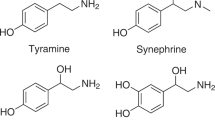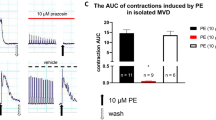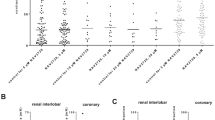Abstract
Trace amines including tyramine and β-phenylethylamine (β-PEA) increase blood pressure and cause vasoconstriction which is attributed to indirect sympathomimetic actions. However, there is evidence that they may also have non-sympathomimetic mechanisms. This study examined whether β-PEA causes vasoconstriction of rat aorta by a sympathomimetic action or through the recently described trace-amine-associated receptors (TAAR). Concentration–response curves (CRCs) for β-PEA were constructed either cumulatively or non-cumulatively in rat isolated aortic rings. TAAR-1 and TAAR-4 protein expression was determined in rat aorta by Western blotting and TAAR-1 mRNA by reverse transcriptase polymerase chain reaction (RT-PCR). β-PEA caused concentration-related constriction of rat aorta. The contractions were unaffected by endothelium removal or the nitric oxide synthase inhibitor, \( {N_\omega } \)-nitro-l-arginine methyl ester (l-NAME, 100 μM) or the cyclooxygenase inhibitor, indomethacin (10 μM). Non-cumulative CRCs showed greater contractions and sensitivity to β-PEA than cumulative. The α1-adrenoceptor antagonist, prazosin, failed to inhibit either curve. The β-adrenoceptor antagonist, propranolol, the adrenergic neuronal transport inhibitor, cocaine, and the monoamine oxidase inhibitor, pargyline, also failed to alter the CRC. In the combined presence of prazosin, cocaine, pargyline, and the selective β2-adrenoceptor antagonist, ICI-118,551, the trace amine contractile potency order was tryptamine > β-PEA > octopamine > d-amphetamine > tyramine. Western blotting and RT-PCR revealed the presence of TAAR-1 in rat aorta, but TAAR-4 was poorly expressed. Vasoconstriction of rat aorta by β-PEA appears not to be an indirect sympathomimetic action. The presence of TAAR-1 suggests that vasoconstriction may be via these receptors; however, the potency order differed from that reported for transfected cells expressing rat TAAR-1.









Similar content being viewed by others
References
Al-Motarreb AL, Broadley KJ (2003) Coronary and aortic vasoconstriction by cathinone, the active constituent of khat. Auton Autacoid Pharmacol 23:319–326
Al-Motarreb A, Baker K, Broadley KJ (2002) Khat: pharmacological and medical aspects and its social use in Yemen. Phytother Res 16:403–413
Anderson R, Ramafi G, Theron AJ (1996) Membrane stabilizing, anti-oxidative interactions of propranolol and dexpropranolol with neutrophils. Biochem Pharmacol 52:341–349
Baker KE, Broadley KJ (2003) Vascular actions of ecstasy: role of adrenergic neurones, endothelin, thromboxane, 5-HT, angiotensin and alpha1-receptors. Br J Pharmacol 138:166P
Baker KE, Herbert AA, Broadley KJ (2007) Vasoconstriction of porcine left anterior descending coronary artery by ecstasy and cathinone is not an indirect sympathomimetic effect. Vasc Pharmacol 47:10–17
Berry MD (2004) Mammalian central nervous system trace amines. Pharmacologic amphetamines, physiologic neuromodulators. J Neurochem 90:257–271
Bilski AJ, Halliday SE, Fitzgerald JD, Wale JL (1983) The pharmacology of a beta 2-selective adrenoceptor antagonist (ICI 118, 551). J Cardiovasc Pharmacol 5:430–437
Bonetta S, Bonetta S, Carraro E, Coisson JD, Travaglia F, Ariorio M (2008) Detection of biogenic amine producer bacteria in a typical Italian goat cheese. J Food Prot 71:205–209
Borowsky B, Adham N, Jones KA, Raddatz R, Artymyshyn R, Ogozalek KL, Durkin MM, Lakhlani PP, Bonini JA, Pathirana S, Boyle N, Pu X, Kouranova E, Lichtblau H, Ochoa FY, Branchek TA, Gerald C (2001) Trace amines: identification of a family of mammalian G protein-coupled receptors. Proc Natl Acad Sci U S A 98:8966–8971
Branchek T, Blackburn T (2003) Trace amine receptors as targets for novel therapeutics: legend, myth and fact. Curr Opin Pharmacol 3:90–97
Brawley L, Shaw AM, MacDonald A (2000) Beta 1-, beta 2- and atypical beta-adrenoceptor-mediated relaxation in rat isolated aorta. Br J Pharmacol 129:637–644
Broadley KJ (1996) Autonomic pharmacology. Taylor & Francis, London
Broadley KJ (2010) The vascular effects of trace amines and amphetamines. Pharmacol Ther 125:363–375
Broadley KJ, Penson PE (2006) Effects of hypoxia on the vasodilator activity of nifedipine and evidence of secondary pharmacological properties. Eur J Pharmacol 536:279–286
Broadley KJ, Anwar MA, Herbert AA, Fehler M, Jones EM, Davies WE, Kidd EJ, Ford WR (2009) Effects of dietary amines on the gut and its vasculature. Br J Nutr 101:1645–1652
Bunzow JR, Sonders MS, Arttamangkul S, Harrison LM, Zhang G, Quigley DI, Darland T, Suchland KL, Pasumamula S, Kennedy JL, Olson SB, Magenis RE, Amara SG, Grandy DK (2001) Amphetamine, 3,4-methylenedioxymethamphetamine, lysergic acid diethylamide, and metabolites of the catecholamine neurotransmitters are agonists of a rat trace amine receptor. Mol Pharmacol 60:1181–1188
Burchett SA, Hicks TP (2006) The mysterious trace amines: protean neuromodulators of synaptic transmission in mammalian brain. Prog Neurobiol 79:223–246
Day MD (1967) The lack of crossed tachyphylaxis between tyramine and some other indirectly acting sympathomimetic amines. Br J Pharmacol Chemother 30:631–643
Fischer LG, Hollmann MW, Horstman DJ, Rich GF (2000) Cyclooxygenase inhibitors attenuate bradykinin-induced vasoconstriction in septic isolated rat lungs. Anesth Analg 90:625–631
Folger WH, Lawson D, Wilcox CS, Mehta JL (1991) Responses of rat thoracic aortic rings to thromboxane mimetic U-46, 619: roles of endothelium-derived relaxing factor and thromboxane A2 release. J Pharmacol Exp Ther 258:669–675
Frascarelli S, Ghelardoni S, Chiellini G, Vargiu R, Ronca-Testoni S, Scanlan TS, Grandy DK, Zucchi R (2008) Eur J Pharmacol 587:231–236
Herbert AA, Kidd EJ, Broadley KJ (2008) Dietary trace amine-dependent vasoconstriction in porcine coronary artery. Br J Pharmacol 155:525–534
Hoyer D, Hannon JP, Martin GR (2002) Molecular, pharmacological and functional diversity of 5-HT receptors. Pharmacol Biochem Behav 71:533–554
Hudgins PM, Fleming WW (1966) A relatively nonspecific super sensitivity in aortic strips resulting from pretreatment with reserpine. J Pharmacol Exp Ther 153:70–80
Kobayashi Y, Zenda H, Chiba S (1992) Existence of beta 1- and beta 2 adrenoceptors in rat abdominal aorta. Asia Pac J Pharm 7:277–281
Krishnamurty VSR, Grollman A (1972) Contractile responses of rat aorta to norepinephrine and tyramine. J Pharmacol Exp Ther 182:264–272
Kuchii M, Shibata S, Mori J (1973) Pharmacological nature of adrenergic innervation in rat aorta. Comp Gen Pharmacol 4:131–138
Lefer AM, Smith EF, Araki H, Smith JB, Aharony D, Claremon DA, Magolda RL, Nicolaou KC (1980) Dissociation of vasoconstrictor and platelet aggregatory activities of thromboxane by carbocyclic thromboxane A2, a stable analog of thromboxane A2. Proc Natl Acad Sci U S A 77:1706–1710
Lemberger HF, Mason N, Cohen ML (1984) 5HT2 receptors in the rat portal vein: desensitization following cumulative serotonin addition. Life Sci 35:71–77
Leung TF, Tang NL, Lam CW, Li AM, Chan IH, Ha G (2002) Thromboxane A2 receptor gene polymorphism is associated with the serum concentration of cat-specific immunoglobulin E as well as the development and severity of asthma in Chinese children. Pediatr Allergy Immunol 13:10–17
Lewin AH (2006) Receptors of mammalian trace amines. Aaps 8:E138–E145
Lindemann L, Hoener MC (2005) A renaissance in trace amines inspired by a novel GPCR family. Trends Pharmacol Sci 26:274–281
Lindemann L, Ebeling M, Kratochwil NA, Bunzow JR, Grandy DK, Hoener MC (2005) Trace amine-associated receptors form structurally and functionally distinct subfamilies of novel G protein-coupled receptors. Genomics 85:372–385
Maling HM, Fleisch JH, Saul WF (1971) Species differences in aortic responses to vasoactive amines: the effects of compound 48–80, cocaine, reserpine and 6-hydroxydopamine. J Pharmacol Exp Ther 176:672–683
Mao H-M, Chen B-G, Qian X-M, Liu Z (2009) Simultaneous determination of twelve biogenic amines in serum by high performance liquid chromatography. Microchem J 91:176–180
Marcobal A, de la Rivas B, Muñoz R (2006) First genetic characterization of a bacterial β-phenylethylamine biosynthetic enzyme in Enterococcus faecium RM58. FEMS Microbiol Lett 258:144–149
Martinez L, Andres-Trelles F, Hidalgo A (1989) Contraction of various zones of the rat testicular capsule in vitro induced by noradrenaline. Rev Esp Fisiol 45:79–88
Michel M, Wieland T, Tsujimoto G (2009) How reliable are protein-coupled receptor antibodies? Naunyn-Schmiedeberg’s Arch Pharmacol 379:385–388
Molenaar P, Christ T, Ravens U, Kaumann A (2006) Carvedilol blocks beta2- more than beta1-adrenoceptors in human heart. Cardiovasc Res 69:128–139
Murphy DL, Karoum F, Pickar D, Cohen RM, Lipper S, Mellow AM, Tariot PN, Sunderland T (1998) Differential trace amine alterations in individuals receiving acetylenic inhibitors of MAO-A (clorgyline) or MAO-B (selegiline and pargyline). J Neural Transm Suppl 52:39–48
O’Donnell SR, Wanstall JC (1984a) Beta-1 and beta-2 adrenoceptor-mediated responses in preparations of pulmonary artery and aorta from young and aged rats. J Pharmacol Exp Ther 228:733–738
O’Donnell SR, Wanstall JC (1984b) The classification of beta-adrenoceptors in isolated ring preparations of canine coronary arteries. Br J Pharmacol 81:637–644
Rees DD, Palmer RM, Schulz R, Hodson HF, Moncada S (1990) Characterization of three inhibitors of endothelial nitric oxide synthase in vitro and in vivo. Br J Pharmacol 101:746–752
Rice PJ, Taylor DA, Valinski WA, Head RJ, Fleming WW (1987) Norepinephrine depletion and sensitivity changes in rat heart induced by pretreatment with reserpine. J Pharmacol Exp Ther 240:764–771
Scanlan TS, Suchland KL, Hart ME, Chiellini G, Huang Y, Kruzich PJ et al (2004) 3-Iodothyronamine is an endogenous and rapid-acting derivative of thyroid hormone. Nat Med 10:638–642
Schachter D, Sang JC (1997) Regional differentiation in the rat aorta: effects of cyclooxygenase inhibitors. Am J Physiol 273(3 Pt 2):H1478–H1483
Schonfeld CL, Trendelenburg U (1989) The release of 3H-noradrenaline by p- and m-tyramines and -octopamines, and the effect of deuterium substitution in alpha- position. Naunyn-Schmiedeberg’s Arch Pharmacol 339:433–440
Smit AJ, Meijer S, Wesseling H, Donker AJ, Reitsma WD (1991) The effects of alpha-adrenoceptor blockade on dopamine-induced renal vasodilation and natriuresis. Naunyn-Schmiedeberg’s Arch Pharmacol 343:143–148
Smith PL, McCafferty GP, Fondacaro JD, Wasserman MA, Elton E, Ryan FM (1988) Effects of putative thromboxane receptor agonists and antagonists on rat small intestinal ion transport. J Pharmacol Exp Ther 247:143–149
Stanaszek WF, Kellerman D, Brogden RN, Romankiewicz JA (1983) Prazosin update. A review of its pharmacological properties and therapeutic use in hypertension and congestive heart failure. Drugs 25:339–384
Suzzi G, Gardini F (2003) Biogenic amines in dry fermented sausages: a review. Int J Food Microbiol 88:41–54
Thomas RS, Liddell JE, Murphy L, Pache D, Kidd EJ (2006) An antibody to the β-secretase cleavage site on amyloid b-precursor protein inhibits amyloid β production. J Alzheimer’s Dis 10:79–390
Trachte GJ (1986) Thromboxane agonist (U46619) potentiates norepinephrine efflux from adrenergic nerves. J Pharmacol Exp Ther 237:473–477
Trendelenburg U (1972) Classification of sympathomimetic amines. In: Blascho H, Muscholl E (eds) Catecholamines. Handbook of experimental pharmacology, vol 33. Springer, Berlin, pp 336–362
Varma DR, Chemtob S (1993) Endothelium- and beta-2 adrenoceptor-independent relaxation of rat aorta by tyramine and certain other phenylethylamines. J Pharmacol Exp Ther 265:1096–1104
Varma DR, Deng XF, Chemtob S, Nantel F, Bouvier M (1995) Characterization of the vasorelaxant activity of tyramine and other phenylethylamines in rat aorta. Can J Physiol Pharmacol 73:742–746
Zucchi R, Chiellini G, Scanlan TS, Grandy DK (2006) Trace amine-associated receptors and their ligands. Br J Pharmacol 149:967–978
Conflict of interest
The authors declare that they have no conflict of interest.
Author information
Authors and Affiliations
Corresponding author
Rights and permissions
About this article
Cite this article
Fehler, M., Broadley, K.J., Ford, W.R. et al. Identification of trace-amine-associated receptors (TAAR) in the rat aorta and their role in vasoconstriction by β-phenylethylamine. Naunyn-Schmied Arch Pharmacol 382, 385–398 (2010). https://doi.org/10.1007/s00210-010-0554-1
Received:
Accepted:
Published:
Issue Date:
DOI: https://doi.org/10.1007/s00210-010-0554-1




